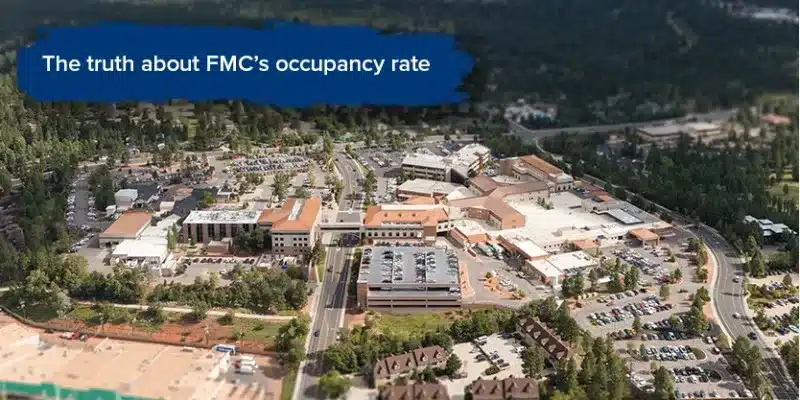Over the last couple of weeks, opponents of Proposition 480 and the new regional hospital project have been repeating a misleading figure: that Flagstaff Medical Center’s (FMC) occupancy rate is only 68%. The opponents have used this number to claim that the existing campus is being under-utilized and not in need of replacement. The true statistics prove otherwise.
The opponents pulled the 68% occupancy rate from FMC’s 2022 Hospital Uniform Accounting Report (UAR) filed with the Arizona Department of Health Services (ADHS) and is available online at https://apps.azdhs.gov/HFCR/. This is the average occupancy rate for all 268 licensed inpatient beds at FMC for Fiscal Year (FY) 2022 (July 1, 2021 – June 30, 2022) [1]. This number does not reflect the occupancy rates for each particular unit or accurately reflect the capacity issues faced by FMC on a day-to-day basis.
To explain, the 268 licensed beds at FMC are designated as follows:
| Bed Type | Licensed Beds |
| Med/Surg | 154 |
| ICU/CCU | 41 |
| Pediatrics (PEDS/ICU/CCU) | 14 |
| Labor & Delivery (LDRP/Postpartum) | 15 |
| Special Care Nursery (SCN) | 18 |
| Behavioral Health (BH) | 26 |
| Total | 268 |
Med/Surg units are the beds that most people would think about as standard inpatient hospital beds. ICU beds are for admitted patients in need of a higher level of care. The other 73 beds at FMC are all designated for various specialties and are not interchangeable with Med/Surg, ICU or any of the other specialty units when a capacity need arises. The 26 licensed inpatient BH beds can only be used for BH patients; in fact, these beds are on a separate floor with additional access controls from the other hospital units and are further divided and restricted by adults on one side and adolescents on the other side of the BH unit. This is also true for PEDS, LDRP/Postpartum and SCN. When Med/Surg beds are full, a facility cannot admit additional general adult patients from the Emergency Department (ED). This remains true even if there are LDRP/Postpartum, PEDS or BH beds available.
When reporting to ADHS through the UAR, all licensed beds are just reported together as 268 licensed beds. If the specialty units are only half-full on average, FMC’s report to ADHS will show 36 open inpatient beds on average, even though those beds cannot be used for any other type of treatment other than the designated specialty.
Additionally, FMC has 36 ED beds, which are not included in the 268-bed count. ADHS considers those beds as “unlicensed” beds. The capacity and throughput issues at FMC are primarily caused by a lack of available Med/Surg, ICU, and ED beds. Generally, the Med/Surg and ICU units run at about an 85-90% occupancy rate. This rate typically increases during the winter months, which is FMC’s highest utilization season. And, 34 of the Med/Surg beds are in “double occupancy,” semi-private rooms that frequently must be limited to one patient for infection prevention or gender rule-out necessities (22 of FMC’s BH beds are in semi-private rooms).
As an example of how the topline UAR number is misleading: if the Med/Surg units are near 90% (the average occupancy rate for FY2022), ICU units are at about 83% capacity (the average rate for FY2022, reflected by the data on lines 73-74 of the UAR), the women and infant’s specialty units (PEDS, LDRP/Postpartum and SCN) are approximately 60%, and BH is only at 50% capacity (both average rates for FY2022), then the overall occupancy rate of FMC would be reported at about 70%, even though the standard adult inpatient units and the ED would be nearing full utilization. Patients arriving at the ED would experience a long wait time and would be waiting in the ED due to a lack of Med/Surg or ICU beds in which to place them post-admission.
The new replacement hospital proposed by Northern Arizona Healthcare will increase Med/Surg and ICU beds, and increase ED beds, while either expanding on or improving the individual specialty units. These upgrades will directly improve patient throughput and lower wait times in the ED.
And, 34 of the Med/Surg beds are in “double occupancy,” semi-private rooms that frequently must be limited to one patient for infection prevention or gender rule-out necessities (22 of FMC’s BH beds are in semi-private rooms).
[1] See Arizona Revised Statute (A.R.S.) § 36-125.04(C)(5); Arizona Administrative Code (A.A.C.) R9-11-203(C)(17).
For more information on the new hospital, read:
We want to build the hospital this community needs
Why the region needs a new hospital
How we’re staffing a new facility
How our project is 100% privately funded
Why more single rooms are needed to meet current care standards
